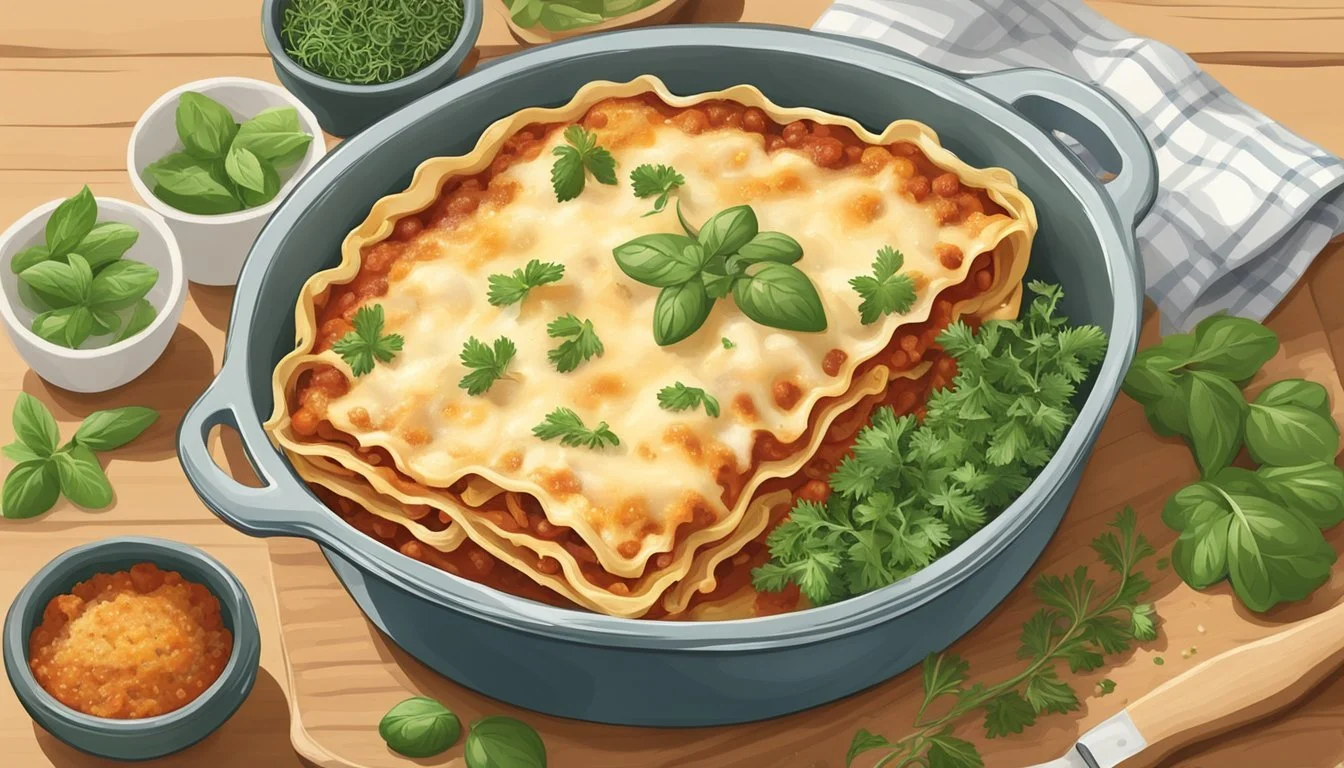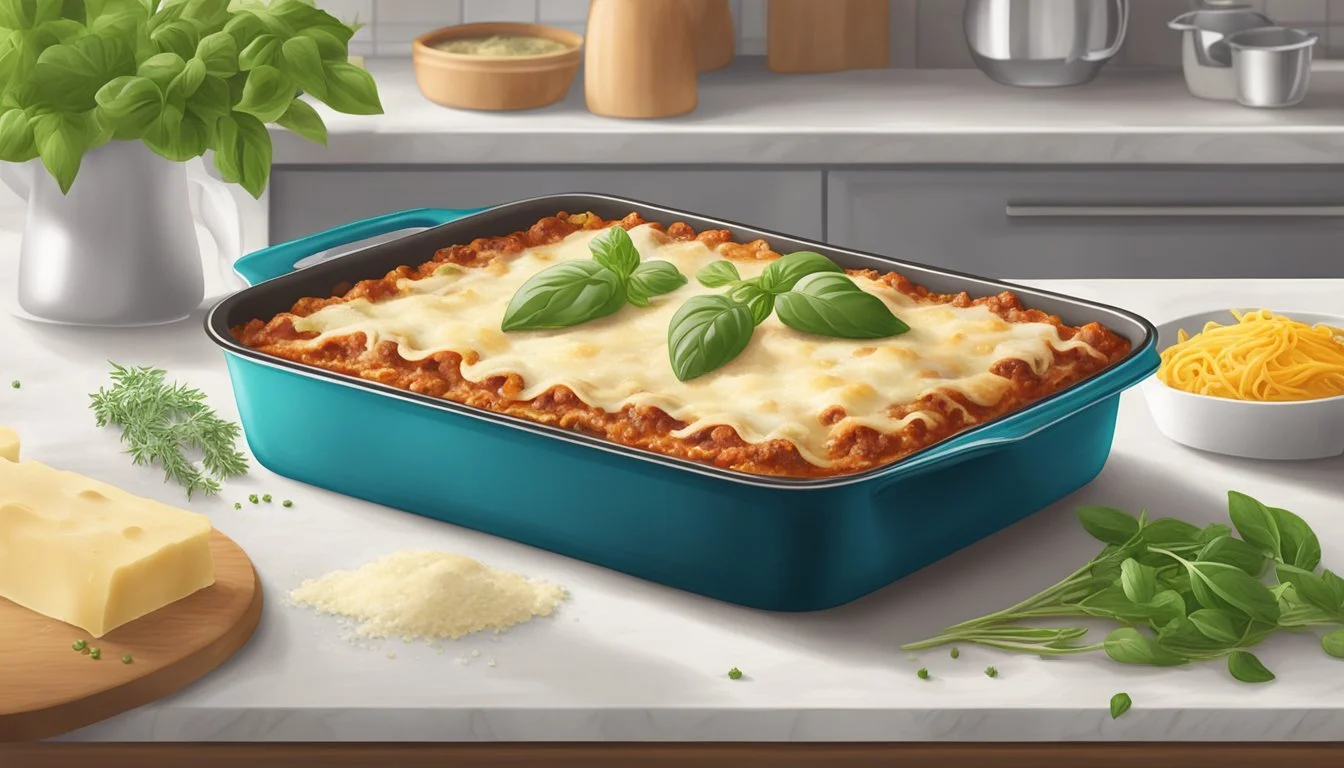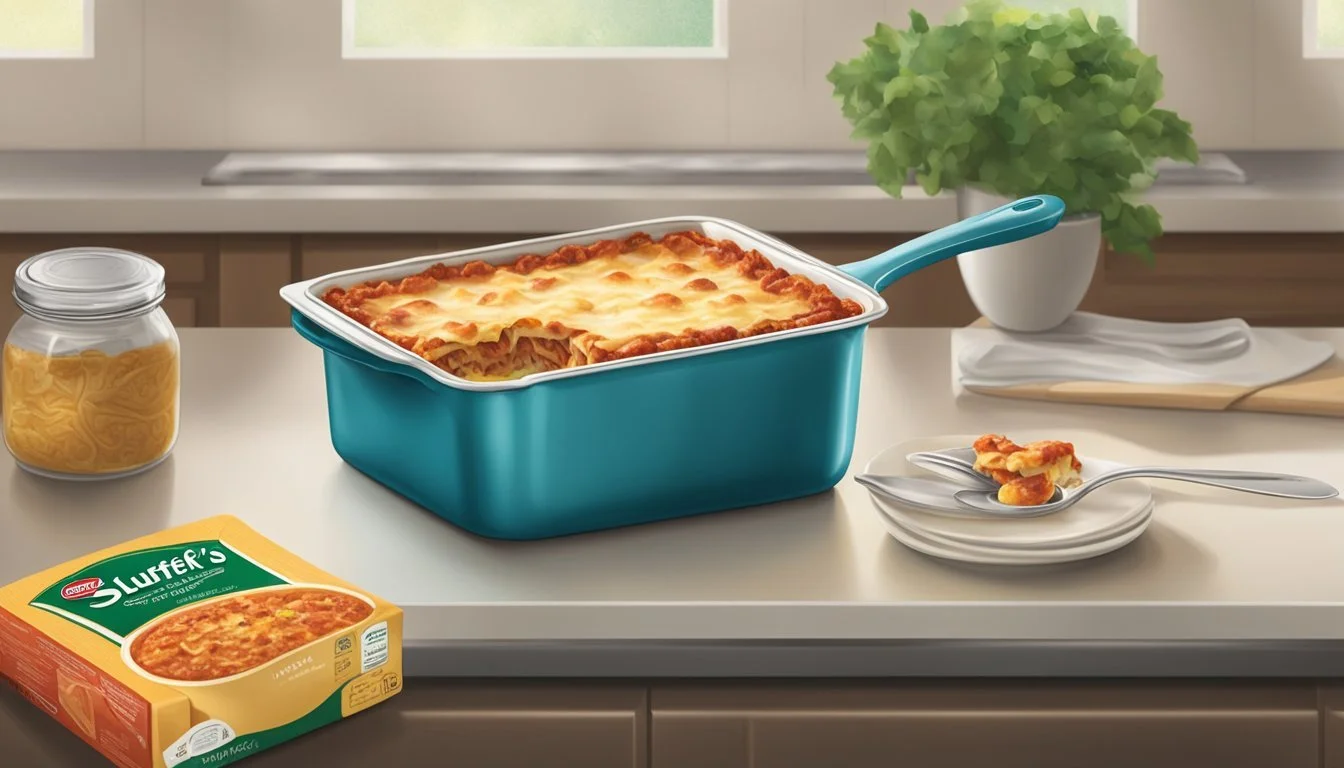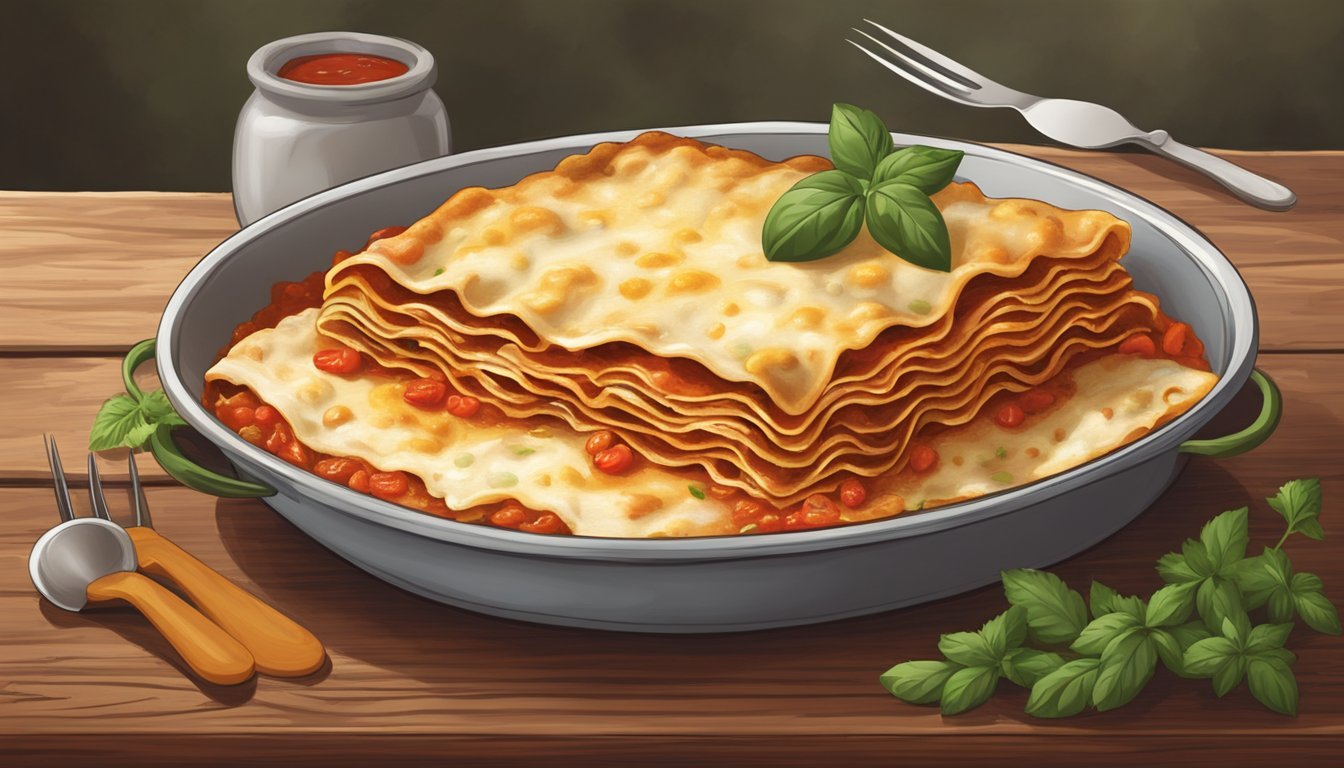How to Cook with Stouffer's Lasagna
Creating a Comforting Main Course
Stouffer's lasagna has become a go-to for many households looking for the comfort of a home-cooked meal with the convenience of a frozen entree. Cooking Stouffer’s lasagna is relatively straightforward, making it an easy choice for a hearty main dish. The rich layers of pasta, cheese, and savory sauce are not only filling but provide a satisfying option for both family dinners and social gatherings, ensuring a comforting meal with minimal prep time.
To achieve the best results, the lasagna must be cooked properly. Whether one is preparing it from frozen or thawed state, the process is designed to deliver a delicious, bubbly, and perfectly cooked lasagna. It requires an understanding of the right oven temperature, cooking duration, and whether or not to cover the dish during the baking process. Adhering to these steps ensures that the lasagna cooks evenly and develops the desired blend of textures and flavors.
To complement the lasagna, it’s often served with simple sides such as a crisp green salad or slices of garlic bread. This classic combination allows the lasagna to take center stage while providing a balanced meal. For those looking to customize their experience, Stouffer's lasagna also pairs well with a variety of accompaniments, ranging from steamed vegetables to a robust red wine.
Preparation Essentials
Before indulging in the rich layers of Stouffer's Lasagna, one must note the key elements of preparation. Ensuring the use of the correct product, gathering necessary ingredients, and preheating the oven to the desired temperature are fundamental for a delicious outcome.
Choosing the Right Lasagna
Frozen: When choosing a Stouffer's Lasagna, it’s important to consider the freezer shelf life and check for any signs of freezer burn. For a standard oven, one can opt for the frozen variety, synonymous with convenience.
Assembling Ingredients
Ingredients: Depending on the lasagna choice, additional ingredients might include ground beef for extra protein or vegetables for a more nutritious option.
Baking Dish: The appropriate baking dish should comfortably fit the lasagna while allowing space for heat circulation. Too tight and the lasagna may not cook evenly; too loose and it might dry out.
Preheating the Oven
Preheat: Always start by preheating the oven. If the product is frozen, setting the oven to 400°F creates the ideal cooking environment.
Oven: A consistent temperature in the oven guarantees that every layer cooks through perfectly.
Aluminum Foil: Cover the baking dish with aluminum foil before placing it in the oven to protect the lasagna from direct heat and prevent over-browning of the cheese.
Cooking Instructions
Preparing Stouffer's Lasagna is straightforward. It requires baking the frozen meal to perfection, checking for doneness, and allowing it to rest for the flavors to meld.
Baking Stouffer's Lasagna
Preheat your oven to the temperature indicated on the Stouffer's Lasagna package, often 375°F. The lasagna should be placed on a baking sheet, which is then set on the center rack of the preheated oven to ensure even cooking. Bake with the cover on for approximately 60-70 minutes. It is advisable to use oven mitts when handling the hot baking sheet to prevent burns.
Checking Doneness
To ensure the lasagna has cooked through, check that it has reached an internal temperature of 165°F at the center, using a food thermometer. The cheese on top should appear golden brown and bubbly.
Resting Period After Baking
After baking, remove the Stouffer's Lasagna from the oven and let it rest for at least 5 minutes. This resting period allows the heat to distribute evenly and the cheese layer to set, making slicing easier.
Reheating Guidelines
When reheating Stouffer's Lasagna, one can choose between the microwave and oven methods. Each approach ensures the lasagna maintains its flavor and texture when followed correctly.
Microwave Method
In the microwave, one should place the lasagna in a microwave-safe dish. To retain moisture, cover it with a piece of microwave-safe plastic wrap or a damp paper towel.
Step 1: Place the lasagna in a microwave-safe dish.
Step 2: Cover with plastic wrap or a damp paper towel to keep it moist.
Step 3: Heat on high for 90 seconds, then check for warmth.
Step 4: If necessary, continue heating in 30-second intervals until thoroughly heated.
Oven Method
Reheating in the oven is ideal for evenly warming the lasagna. One should preheat the oven and cover the lasagna with aluminum foil to prevent the top from drying out or burning.
Step 1: Preheat the oven to 350°F (175°C).
Step 2: Place the lasagna in an oven-safe dish and loosely tent with aluminum foil.
Step 3: Bake on the middle rack. For refrigerated lasagna, bake for 20-30 minutes. For frozen, adjust time accordingly.
Step 4: For a crispy top, remove the foil in the last few minutes.
Complementary Dishes and Pairings
To enhance the overall dining experience, the selection of side dishes and beverages plays a pivotal role. Accompanying a hearty main course like Stouffer's Lasagna with a well-crafted salad and a thoughtfully chosen beverage can turn a simple meal into a gourmet feast.
Creating the Perfect Side Salad
When crafting the ideal side salad to accompany lasagna, one should emphasize freshness and lightness to balance the richness of the main dish. A classic combination includes:
Crisp lettuce or mixed greens
Sliced cucumber
Cherry tomatoes
Red onion rings
Dress the salad with a homemade vinaigrette composed of three parts olive oil to one part vinegar, a touch of minced garlic, and seasonings like salt, pepper, and a sprinkle of basil. For a final touch, consider a garnish such as shaved Parmesan or croutons for added texture.
Selecting a Complementary Beverage
Choosing the right beverage to serve with lasagna can complement the flavors and enhance the meal. Here are a few suggestions:
For red wine enthusiasts, a medium-bodied Chianti or Merlot pairs beautifully, cutting through the richness with its acidity and tannin structure.
If white wine is preferred, a Pinot Grigio with its crisp and slightly fruity profile is a delightful choice.
Non-alcoholic options could include sparkling water with a slice of lemon to refresh the palate or an iced tea garnished with a sprig of basil for an aromatic touch.
Storage and Food Safety
When enjoying Stouffer's Lasagna, proper storage and adherence to food safety standards are paramount to maintain both the quality and safety of the meal. These practices ensure the lasagna remains a comforting and safe dish to consume.
Storing Leftovers
Stouffer's Lasagna leftovers should be stored in an airtight container to preserve freshness. If an airtight container is not available, wrapping the lasagna tightly with plastic wrap can be an alternative. To prevent bacterial growth, leftovers must be placed in the refrigerator within two hours of cooking. The lasagna should be consumed within three to five days for the best quality and safety. To reheat, simply bake in the oven or warm in the microwave until the internal temperature reaches 165°F (74°C).
Understanding Food Safety Standards
It's imperative for consumers to be mindful of food safety when handling and storing Stouffer's Lasagna. Here are key nutritional aspects to consider:
Saturated Fat and Cholesterol: Overconsumption can be a concern for heart health.
Sodium: Keep track of intake to manage blood pressure.
Protein: Essential for body repair and maintenance.
Sugar: Limit intake to reduce the risk of chronic diseases.
Milk: Used in lasagna, it should be stored properly to avoid spoilage.
Consumers must ensure the lasagna is cooked according to the instructions before consumption to safely reach the required internal temperature, and storing the meal properly greatly minimizes the risk of foodborne illnesses.
Tips and Tricks for a Flawless Meal
When preparing a Stouffer's Lasagna, one has the opportunity to elevate the flavors and address any possible baking issues. Integrating personalized touches and understanding how to remedy common setbacks can transform an ordinary meal into a standout dish.
Tweaking the Recipe for Customization
Incorporate More Flavors: To compliment the lasagna, one might consider adding extra herbs such as basil or oregano. These can be sprinkled on top before baking or mixed into any additional cheese layers for a flavor boost.
Adding Meat: For non-vegetarians, browning some ground beef or Italian sausage adds richness. Ensure the meat is fully cooked before layering it into the lasagna to maintain a safe cooking process.
Vegetable Variations: If one desires a more nutritious twist, incorporating spinach, zucchini, or bell peppers enriches the vegetable content.
Cheese Adjustments: To make the dish extra indulgent, one can add a variety of cheeses. Mozzarella, ricotta, or even a sprinkle of Parmesan can enhance the cheesy goodness. Be mindful that adding extra cheese may extend baking times slightly.
Troubleshooting Common Baking Issues
Uneven Cooking: Should parts of the lasagna cook faster than others, check the oven's temperature and consider rotating the dish halfway through the baking process.
Cheese Burning: If the cheese begins to burn while the center is still cold, a sheet of aluminum foil can prevent further browning. Remove this cover during the final 10 minutes for a perfectly golden finish.
Too Much Liquid: In case the lasagna appears too watery upon completion, allowing it to rest will enable absorption and help set the layers. A resting time of 10-15 minutes is recommended.
Frozen Center: If the center remains frozen, extend cooking time in increments of 10 minutes, checking frequently until the desired temperature is reached. Always refer to the packaging instructions as the primary guide for cooking times.
By utilizing these tips, chefs can ensure their Stouffer's Lasagna is not just convenient but also a customized and delicious centerpiece for any meal.
Understanding Cooking Appliances
When cooking Stouffer’s Lasagna, the appliance used can significantly affect the texture and taste. Understanding the nuances of different ovens is essential for achieving the desired outcome.
Using a Convection Oven
A convection oven works by circulating hot air to ensure even cooking. It's an ideal choice for heating Stouffer’s Lasagna as it typically shortens the cooking time and promotes even browning. The key steps include:
Preheating: Always preheat the convection oven to the temperature specified on the lasagna’s packaging, usually around 350°F.
Placement: Center the lasagna on the oven rack to promote even air circulation.
Be mindful that convection ovens may cook food up to 25% faster than traditional ovens, so one should adjust cook times accordingly.
Options for Small-Scale Appliances
When using smaller appliances, such as a toaster oven, one must adjust their approach. Here’s what to consider:
Size Constraints: Confirm the lasagna fits comfortably within the toaster oven to avoid overheating or spillover.
Temperature Settings: Set the toaster oven to bake at the recommended temperature, keeping in mind that it may heat up more quickly than a full-size oven.
Monitoring: Due to their compact size, toaster ovens can cause the top of the lasagna to brown more rapidly. Covering with foil may help prevent over-browning.
Whether one chooses a convection oven or a smaller toaster oven, the focus should be on monitoring the lasagna throughout the cooking process to ensure it reaches the perfect temperature and consistency.
Nutritional Information
Stouffer's Lasagna is a convenient and tasty meal option, but consumers should be aware of its nutritional content to suit their dietary needs and preferences.
Health Benefits and Dietary Considerations
Stouffer's Lasagna offers a source of protein, with varying amounts depending on the specific product, such as the Meat Lovers or classic Lasagna with Meat and Sauce. This protein primarily comes from the beef and cheese used in the lasagna. These ingredients also contribute to the saturated fat, cholesterol, and sodium content of the dish. While these are important nutrients, they should be consumed within the recommended daily limits to maintain a balanced diet.
The lasagna contains milk in the form of mozzarella cheese, offering calcium which is essential for bone health. For those with lactose intolerance or dairy allergies, it is crucial to note the presence of dairy to manage their conditions accordingly.
In terms of sugar, the lasagna typically has a relatively low sugar content as it is primarily a savory dish. However, the tomato sauce may contain some sugars. Those monitoring their sugar intake for dietary or medical reasons should consider this aspect when including Stouffer's Lasagna in their meal planning.
Below is a simplified nutritional breakdown for a general reference. For specific nutritional details, consumers should refer to the product's packaging or the manufacturer's website:
Nutrient Amount (Approx.) Protein Varies Saturated Fat Varies Cholesterol Varies Sodium Varies Sugar Low Milk Present
Individuals with particular diet restrictions or health considerations should take into account these nutritional aspects to ensure Stouffer's Lasagna aligns with their dietary goals. It's always recommended to check with a healthcare provider or dietician when making significant dietary changes.
FAQs and Expert Advice
Cooking Stouffer's Lasagna needs specific attention to detail when it comes to temperature, water content, and cooking time. This section responds to common concerns and queries to ensure that one can prepare a satisfying main course.
Responding to Common Inquiries
How should Stouffer's Lasagna be cooked for the best result?
For optimal flavor and texture, the lasagna should be cooked according to package instructions. However, cooking times may need slight adjustments based on the oven's accuracy and altitude. It's recommended to start checking the lasagna 10-15 minutes before the stated cook time concludes.
Is there a need to add water to Stouffer's Lasagna before cooking?
No additional water is required when cooking a Stouffer's Lasagna. The frozen meal is designed to bake to perfection straight from the box.
What temperatures are appropriate for cooking Stouffer's Lasagna?
Typically, ovens should be preheated to 375°F for conventional cooking and 400°F if following the convectional instructions. Ensuring the oven has reached the correct temperature before cooking is vital for even cooking.
How can one tell if the lasagna pasta is fully cooked?
The pasta should be tender to the bite without being overly soft. To test, one should insert a fork or toothpick into the center of the lasagna; it should go through easily without resistance.
When cooking Stouffer's Lasagna, is there a difference between the frozen and thawed cooking methods?
Yes, cooking times differ greatly between if the lasagna is frozen or thawed. If cooking from a frozen state, expect a longer cook time, while a thawed lasagna will cook in a significantly shorter period.
Are there any specific tips for cooking frozen meals like Stouffer's Lasagna to ensure they don't dry out?
To prevent drying out, one should ensure that the lasagna is tightly covered with foil for the majority of the baking process. The foil helps to lock in moisture. If desired, a crispy top can be achieved by removing the foil for the final minutes of cooking.








